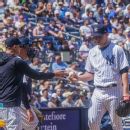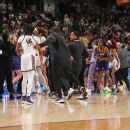Grab this quartet of underachievers quickly
The 2023 season has had its share of underperforming teams, including the New York Mets, San Diego Padres, Seattle Mariners and Toronto Blue Jays — teams whose championship odds during the preseason ranked among the game’s top 10. Combined, those teams begin play on Wednesday with a .500 winning percentage.
Taking a closer look at the rosters of each of these four teams, there’s an individual on each of them whose play, for whatever reason, has had a big say in his team’s underperformance. Improved play — or simply better luck on balls in play — by each could have significant sway in terms of the outcome for the rest of the season, but most importantly for our purposes, these individuals rate among fantasy baseball’s better “buy low” candidates.
Make your trade pitches for these four players now, and in at least one case, that’s an “all in” — as in, anything beneath preseason draft prices — recommendation.
 Francisco Lindor, SS, Mets: Doesn’t it feel like we were right here at this same point of each of his first two seasons with the Mets? Here’s a comparison of Lindor’s numbers through 61 team games over the last three campaigns:
Francisco Lindor, SS, Mets: Doesn’t it feel like we were right here at this same point of each of his first two seasons with the Mets? Here’s a comparison of Lindor’s numbers through 61 team games over the last three campaigns:
-
2021: .214/.316/.341, 6 HR, 16 RBI, 5 SB, 121 fantasy points
-
2022: .249/.328/.421, 9 HR, 45 RBI, 8 SB, 166 fantasy points
-
2023: .214/.287/.416, 11 HR, 42 RBI, 4 SB, 138 fantasy points
In both 2021 and 2022, Lindor averaged better than 2.6 fantasy points per game — the average cited there because he did spend 38 days of 2021 on the IL due to an oblique issue — from this point of the season forward, giving him the look of a second-half performer. His career trends support that because post-July 1, he has a batting average 28 points higher and an OPS 59 points higher, and he has averaged 0.33 fantasy points per game more than his through-June 30 stats. However, this case is as much about the year-over-year stability of his underlying metrics as it is a slow-start, hot-finish reputation.
This season, Lindor’s Statcast expected batting average is 15 points higher and his expected wOBA is 18 points higher than his true numbers, with one of the culprits to his slow start being a career-worst 82% contact rate on pitches within the rulebook strike zone. It’s an unusual shift for him and, to offer some hints of a soon-to-come rebound, he does have five home runs over his past 14 games.
 Joe Musgrove, SP, Padres: One of the key June fantasy baseball takeaways — other than that it’s annually time for Kyle Schwarber to be excellent, which Eric Karabell explained expertly on Monday — is that full-season stats tend to crystallize with the sample size that’s now on the stat sheet, masking significant performance shifts and giving the perception that it’s difficult for a player to improve his numbers. In Musgrove’s case, however, the fractured toe that cost him the first 23 days of the season gives his seasonal stat line (especially his career-worst 1.33 WHIP) a more damning look than it should, not to mention that the injury time probably still sticks enough in many fantasy managers’ memories that it’s hindering his true value.
Joe Musgrove, SP, Padres: One of the key June fantasy baseball takeaways — other than that it’s annually time for Kyle Schwarber to be excellent, which Eric Karabell explained expertly on Monday — is that full-season stats tend to crystallize with the sample size that’s now on the stat sheet, masking significant performance shifts and giving the perception that it’s difficult for a player to improve his numbers. In Musgrove’s case, however, the fractured toe that cost him the first 23 days of the season gives his seasonal stat line (especially his career-worst 1.33 WHIP) a more damning look than it should, not to mention that the injury time probably still sticks enough in many fantasy managers’ memories that it’s hindering his true value.
Musgrove’s underlying metrics, however, hint that he’s as excellent a pitcher as he has been at any prior career stage. His average fastball velocity (93.2 mph) is the highest it has been since 2018, his cutter is performing every bit as well as it did in 2021, he currently has the lowest hard-hit rate of his career (30.9%) and, while both his curveball and slider could stand to improve, the fact that he generated a combined 10 swings-and-misses as well as 23 called strikes on those two offerings over his past three starts hints that he’s turning the corner with both of those pitches.
Peak Musgrove isn’t that far off a top-10 fantasy starting pitcher’s valuation, but you might still be able to acquire him at a price tag outside the positional top 25.
 Logan Gilbert, SP, Mariners: He’s a personal favorite, as a pitcher who has possessed elite four-seam fastball command since Day 1 of his big league career, and one who is constantly seeking ways to improve his overall game. Gilbert most notably added a splitter to his repertoire this season, with that pitch already performing as one of the game’s most effective. However, perhaps more significantly, he has made tweaks to his slider such that the pitch is both moving and performing better than ever.
Logan Gilbert, SP, Mariners: He’s a personal favorite, as a pitcher who has possessed elite four-seam fastball command since Day 1 of his big league career, and one who is constantly seeking ways to improve his overall game. Gilbert most notably added a splitter to his repertoire this season, with that pitch already performing as one of the game’s most effective. However, perhaps more significantly, he has made tweaks to his slider such that the pitch is both moving and performing better than ever.
Gilbert’s slider has exhibited a significant amount of drop — nearly four inches, per Statcast — while dramatically decreasing in terms of both spin rate — more than 300 revolutions per minute! — and lateral movement, giving it more of a sinker/splitter feel that is partly responsible for his near-6% rise in ground ball rate. He now has four potentially elite pitches and is also sporting a personal-best 28.2% strikeout rate, yet somehow has an ERA nearly a full run higher (3.80) than his Statcast expected ERA (2.98). Gilbert, too, totaled 185 2/3 innings in 2022 and plays a critical part in his Mariners’ title hopes, so he shouldn’t have any workload-related restrictions.
Like Musgrove, Gilbert might not be regarded as anywhere close to a top-10 fantasy starter, but his metrics suggest he could make a borderline run at it.
 Vladimir Guerrero Jr., 1B, Blue Jays: The “all in” trade target I hinted at above, Guerrero has followed up his breakthrough, second-in-MVP-balloting 2021 with a more human-looking 2022 and first 62 team games of 2023. A casual glance at his year-to-date stats, fresh on the heels of that 2022 disappointment, might elicit thoughts that his 2021 was the outlier and that maybe he’s “not all that.”
Vladimir Guerrero Jr., 1B, Blue Jays: The “all in” trade target I hinted at above, Guerrero has followed up his breakthrough, second-in-MVP-balloting 2021 with a more human-looking 2022 and first 62 team games of 2023. A casual glance at his year-to-date stats, fresh on the heels of that 2022 disappointment, might elicit thoughts that his 2021 was the outlier and that maybe he’s “not all that.”
Look closer, however, and Guerrero’s underlying metrics look eerily similar to 2021’s, and in fact, some hint at even more MVP-like skills. His Statcast barrel (14.4%), exit velocity (94.3 mph average) and hard-hit rates (56.7%) are right in line with his 2021 numbers (15.1%, 95.1 mph and 55.2%), but he’s getting more elevation than ever before, previously the lone obstacle to his becoming a perennial MVP candidate. Guerrero’s 10.5 degree launch angle and 43.8% ground ball rate would represent personal bests, and he’s making more contact on pitches within the strike zone than ever before (85%). Additionally, one of the things I love most about Guerrero is his desire to contribute on the basepaths, best evidenced by his 11-of-14 performance stealing bases between this and last season, despite what has been bottom-third-in-baseball raw speed.
Guerrero has been awfully ordinary with the bat for the past month, batting .240/.304/.370 with two home runs in 26 games over that time, which might coax those who selected him seventh overall (on average) in the preseason to consider dealing him for an enticing trade package. I don’t think he’s much less of a player than that same individual we drafted in the first round in March, and if you can get him at anything below that price tag, the prospective reward could be tremendous.




